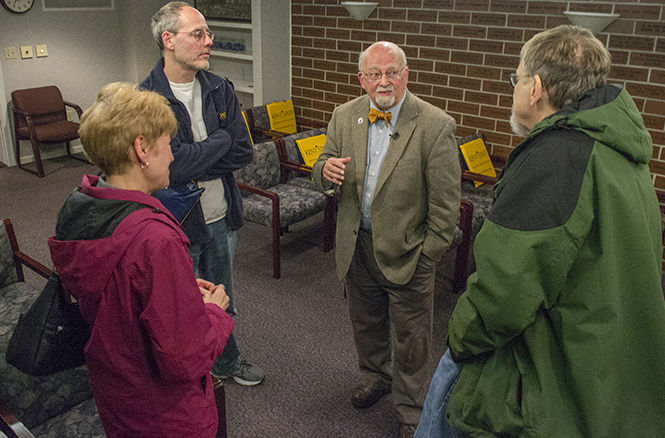Lecture highlights growing issues of sports fan violence
Professor Jerry Lewis, author of the book “Sports Fan Violence in North America,” speaks with alumni following his lecture on sports fan violence and its sociological impact Thursday, Nov. 6, 2014 in the Williamson Alumni Center.
November 6, 2014
A Kent State emeritus professor discussed the behavior of violent sports fans in his “Classes Without Quizzes” lecture titled “Sports Fan Violence: An American Social Problem” Thursday evening in the Williamson Alumni Center.
Jerry Lewis, an emeritus professor of sociology, examined the characteristics of sports fan violence and discussed his research from his book “Sports Fan Violence in North America.”
In his lecture, Lewis defined fan violence as “five or more people involved in acts of violence before, during or after an organized sporting event.”
Lewis specializes in collective behavior in sociology, concentrating on rumors, crowds, disasters and social movements. He began his research on social issues involving the Kent State May 4 shootings and eventually became involved in sports-related violence.
His research showed that most sports fan violence occurs after sporting events, such as championship games or a rivalry match, and found that young, white males are typically the instigators.
“Young, white males tend to be risk-takers,” Lewis said. “Black males do not see the point in a fight, and women choose to stay out of harm’s way.”
Lewis has three theories as to why sports fans behave so violently: crazy behavior, alcohol and fatigue.
Lewis said fan violence occurs in a specific order called “The Riot Sequence”. The riot sequence begins with a gesture, such as a fan throwing their arms up in the air to symbolize a touchdown, followed by provocative words and then the need to throw objects.
“Sports fans around here tend to set couches on fire,” Lewis said as the audience laughed.
In addition to discussing his research and book, Lewis also talked about professional sporting events where celebratory riots took place. Audience members contributed with their witness accounts of high school sports violence among parents.
From Atwater, Ohio, Waterloo High School football coach David Neal, a 1976 Kent State education graduate, described an instance of fan violence he experienced on the field while coaching.
“We had one play left, and there was pass interference, but the referee never made a call and time ran out,” Neal said. “The officials then ran off the field, but we had to pull rioting fans off of the refs.”
Lewis said he fears the issue of fan violence will only continue to grow and that eventually shootings will occur. He plans to continue his research on sports-related violence and educate others on this growing issue.
Contact Gabrielle Martinez at [email protected].












